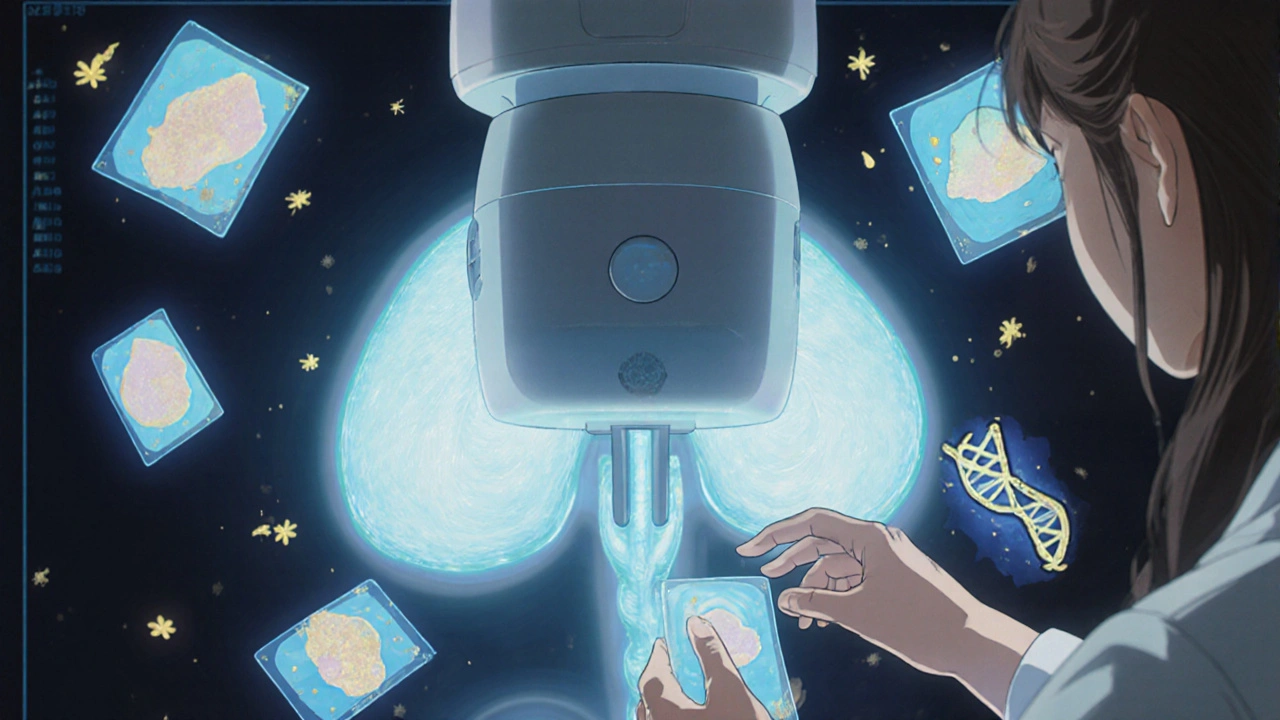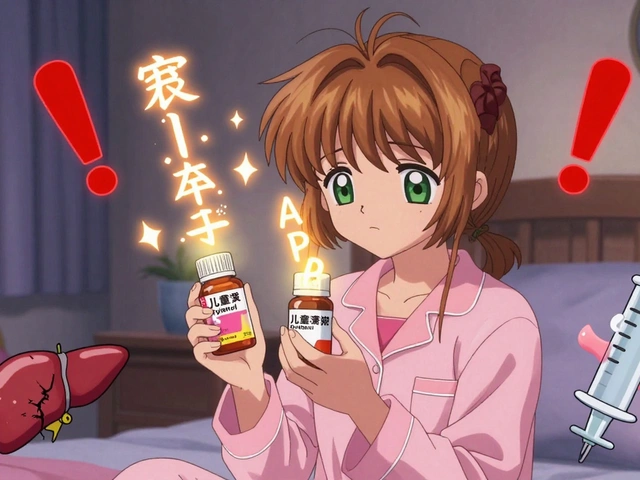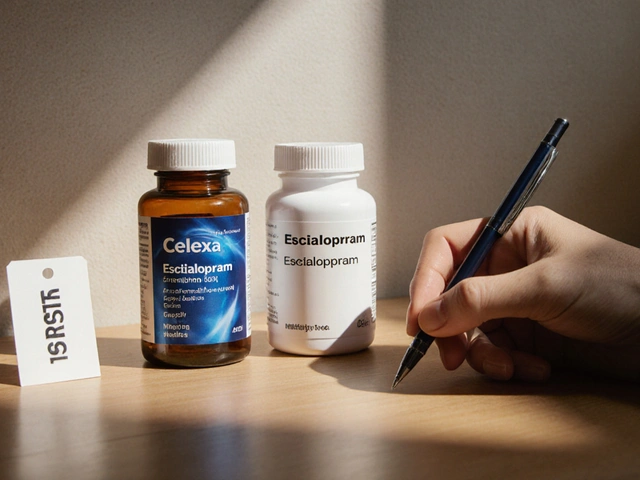When you hear the word breast cancer, what comes to mind? Fear? Uncertainty? It shouldn’t be either. Today, early detection and personalized treatment mean more women than ever are surviving this disease - not just living with it, but living well. The key? Knowing when and how to screen, and understanding what happens next if something is found.
Screening Starts Earlier Than You Think
For years, the conversation around breast cancer screening centered on age 50. But that’s changed. In 2024, the American College of Obstetricians and Gynecologists updated its guidelines to recommend that all women at average risk start annual mammograms at age 40. This wasn’t a random shift. It was based on hard data: breast cancer rates in women under 50 have been rising, and catching tumors earlier saves lives. The U.S. Preventive Services Task Force still says biennial screening (every two years) from age 40 to 74 is sufficient, but they now give a Grade B recommendation for women in their 40s - meaning the benefits clearly outweigh the risks. The American Cancer Society says women 40 to 44 can choose to start yearly screening, while those 45 to 54 should get one every year. After 55, you can switch to every two years - or keep going yearly if you prefer. What’s driving this change? More women are being diagnosed with invasive breast cancer in their 40s than ever before. And screening mammograms have proven they reduce deaths. A major review of nine clinical trials found that regular screening lowers the risk of dying from breast cancer by about 12%. That’s not a small number. That’s 1 in 8 women who might otherwise not make it to their 60s.2D vs. 3D Mammography: What’s the Difference?
Not all mammograms are the same. Most women still get 2D digital mammograms - flat images of the breast from two angles. But 3D mammography, also called digital breast tomosynthesis (DBT), is becoming the new standard. Instead of two flat pictures, DBT takes dozens of thin slices through the breast, creating a 3D reconstruction. It’s like flipping through a book instead of looking at one page. Why does this matter? For women with dense breast tissue - about half of all women - 2D mammograms can miss cancers. Dense tissue shows up white on the image, just like tumors. With 3D imaging, radiologists can see through the layers and spot abnormalities more clearly. Studies show DBT reduces false positives by up to 40% and finds 40% more invasive cancers than 2D alone. The American Society of Breast Surgeons now recommends 3D mammography as the preferred screening tool for everyone, not just those with dense breasts. Medicare and most private insurers cover one baseline mammogram and annual screening mammograms. If you’re over 55 and choose biennial screening, you’re still eligible for yearly exams if you want them.Who Needs More Than a Mammogram?
If you’re at higher risk, screening doesn’t stop at mammography. Risk isn’t just about family history. It’s about genetics, past radiation, dense breasts, or previous precancerous changes like atypical hyperplasia. Women with a lifetime risk of 20% to 25% or higher - based on tools like Tyrer-Cuzick or Gail model - should get both a mammogram and an MRI every year, starting at age 30. MRI is far more sensitive than mammograms at detecting early cancers in high-risk women. The American Cancer Society recommends this for those with BRCA mutations, Li-Fraumeni syndrome, or a strong family history. What about dense breasts without other risk factors? The USPSTF says there’s not enough evidence to recommend ultrasound or MRI as routine supplements. But many doctors still offer them. The American Society of Breast Surgeons advises annual supplemental screening with MRI for women with dense breasts and other risk factors. If your mammogram says you have dense tissue, ask your doctor: “Should I get an MRI?” Don’t rely on self-exams or clinical breast exams alone. The Canadian Task Force and others have found no proven benefit from monthly self-checks or doctor-performed exams in reducing deaths. They’re not harmful, but they’re not substitutes for mammography.
When Does Screening Stop?
There’s no magic age when you stop. The American Society of Breast Surgeons says keep screening as long as your life expectancy is over 10 years. That’s the real cutoff - not your birthday. A healthy 80-year-old with no major illnesses should still get screened. A 70-year-old with advanced heart disease and a life expectancy of 3 years? Probably not. Screening isn’t about age. It’s about whether you’d benefit from catching a cancer early enough to treat it.What Happens After a Diagnosis?
If a mammogram finds something suspicious, the next step isn’t panic. It’s biopsy. A core needle biopsy is the gold standard - it removes a small tissue sample to test for cancer cells. Once cancer is confirmed, treatment begins with staging: figuring out how big the tumor is, whether it’s spread to lymph nodes, and whether it’s hormone-sensitive or HER2-positive. This is where treatment algorithms come in. They’re not one-size-fits-all. A small, estrogen-receptor-positive tumor in a 68-year-old woman might be treated with surgery and hormone therapy alone. A larger, HER2-positive tumor in a 42-year-old might need chemotherapy, targeted drugs, surgery, and radiation. Surgery options include lumpectomy (removing just the tumor) or mastectomy (removing the whole breast). Radiation usually follows lumpectomy. Chemotherapy isn’t automatic - genomic tests like Oncotype DX can tell you if chemo will actually help. If your score is low, you can skip it. If it’s high, you need it. Hormone therapy (like tamoxifen or aromatase inhibitors) is used for 5 to 10 years if the cancer is hormone-sensitive. Targeted drugs like trastuzumab (Herceptin) are used for HER2-positive cancers. These aren’t just treatments - they’re tools to prevent recurrence.
Why Consistency Matters
For years, conflicting guidelines confused patients and doctors. Some said start at 40. Others said 50. Some said yearly. Others said every two years. Now, most major U.S. organizations - ACOG, ACS, ASBrS, NCCN, ACR - are aligned: start at 40, use 3D mammography when possible, screen annually or biennially based on preference, and keep going as long as you’re healthy. This alignment isn’t just about numbers. It’s about equity. Women who delay screening because they’re unsure when to start are more likely to be diagnosed at later stages - especially Black women, who have higher death rates from breast cancer. Clearer guidelines mean fewer missed opportunities.What You Can Do Today
If you’re 40 or older: Schedule your first mammogram. If you’ve never had one, don’t wait. If you’re under 40 but have a family history, talk to your doctor about risk assessment. Ask for the Tyrer-Cuzick model. If your lifetime risk is above 20%, ask about MRI. If you’ve had a mammogram and they said you have dense breasts: Don’t brush it off. Ask if you’re a candidate for supplemental imaging. Don’t accept “it’s not recommended” as the final answer. Push for a conversation. If you’ve been diagnosed: Don’t rush into treatment. Get a second opinion. Ask for genomic testing. Ask what your recurrence risk is. Ask if you can avoid chemo. You have more control than you think. Breast cancer isn’t a death sentence anymore. It’s a condition you can manage - if you catch it early and know your options. Screening isn’t optional. It’s the first step in staying alive.When should I start getting mammograms?
Most major U.S. medical groups now recommend starting annual mammograms at age 40, even if you have no symptoms or family history. The American College of Obstetricians and Gynecologists and the American Society of Breast Surgeons both say 40 is the right age to begin. The U.S. Preventive Services Task Force says biennial screening from 40 to 74 is sufficient, but they now support offering screening to women in their 40s. Start early if you want to catch cancer at its most treatable stage.
Is 3D mammography better than 2D?
Yes, for most women. 3D mammography (digital breast tomosynthesis) finds more invasive cancers and reduces false alarms compared to traditional 2D mammograms. It’s especially helpful for women with dense breast tissue, which covers up tumors in 2D images. While 2D is still widely used, the American Society of Breast Surgeons recommends 3D as the preferred method. Most insurance plans, including Medicare, cover it as part of routine screening.
Do I need an MRI if I have dense breasts?
Not automatically. The U.S. Preventive Services Task Force says there’s not enough evidence to recommend MRI or ultrasound for women with dense breasts but no other risk factors. But if you have a family history, genetic mutation, or prior breast cancer, annual MRI alongside mammography is strongly advised. Ask your doctor to calculate your lifetime risk using the Tyrer-Cuzick model - if it’s over 20%, MRI is recommended.
Can I skip mammograms after 65 or 70?
No - if you’re in good health. Screening should continue as long as your life expectancy is more than 10 years. Many women live well into their 80s and 90s. If you’re healthy enough to benefit from treatment, you’re healthy enough to be screened. Stopping because of age alone can cost lives. The American Society of Breast Surgeons says the cutoff is life expectancy, not birthday.
What if my mammogram shows something suspicious?
Most abnormal mammograms turn out to be benign. But if something looks unusual, the next step is a biopsy - usually a core needle biopsy - to get tissue for testing. Don’t panic. Only about 1 in 10 women called back for further testing end up with cancer. Once diagnosed, your care team will use tumor size, lymph node status, hormone receptors, HER2 status, and genomic tests to build a personalized treatment plan. You’re not alone - this is a well-defined process with proven outcomes.
Are breast self-exams still recommended?
Not as a screening tool. Major guidelines, including those from the Canadian Task Force and U.S. Preventive Services Task Force, say regular self-exams don’t reduce breast cancer deaths. They can lead to unnecessary anxiety and biopsies. But being familiar with how your breasts normally look and feel is still smart. If you notice a new lump, skin change, or nipple discharge, tell your doctor right away - don’t wait for your next mammogram.








Manish Pandya November 25, 2025
Finally, some clear guidelines. I’ve been telling my sister for years to get her first mammogram at 40-she was waiting for ‘the right time.’ Now she’s booked. Thanks for laying it out without the fluff.
Rachelle Baxter November 27, 2025
Ugh. I can’t believe people still think self-exams are useless. My aunt found HER tumor because she felt something weird while showering. You can’t just rely on machines-your body talks, you just have to listen. 🙄
Kaylee Crosby November 27, 2025
As a nurse who’s helped coordinate breast cancer screenings for over a decade, I can tell you this: the data doesn’t lie. 3D mammograms cut down on callbacks by nearly half in our clinic. Women who got them were less stressed and got answers faster. If your facility offers it, push for it. Insurance covers it-don’t let them talk you out of it.
Terry Bell November 28, 2025
Man, I wish I’d known all this when my mom got diagnosed at 52. We thought she was ‘too young’ to worry. Turns out, her tumor was hiding behind dense tissue. If we’d had 3D back then… I don’t know. Maybe she’d still be here. Anyway-don’t wait. Get checked. Even if you feel fine. Your future self will thank you. 🙏
Benjamin Gundermann November 29, 2025
Look, I get it-screening saves lives. But let’s be real: the whole system is a profit machine. Mammogram machines cost $250K. Hospitals make bank on follow-ups. Radiologists get paid per scan. And don’t get me started on the ‘breast cancer awareness’ industrial complex selling pink ribbons while ignoring the real causes-plastics, pesticides, hormone disruptors. Yeah, early detection helps. But why aren’t we talking about prevention? Why are we just pushing more scans instead of fixing the environment? I’m not anti-screening-I’m pro-truth.
Emma Hanna November 29, 2025
Wait-so you’re saying I shouldn’t do self-exams? But what about all those ‘awareness’ campaigns? The commercials? The walks? The free screenings? You can’t just erase decades of public messaging with a few guidelines. People need to feel empowered! And if I’m supposed to ‘just ask my doctor,’ what if my doctor doesn’t listen? What if they’re dismissive? I’m not going to sit around waiting for permission to care about my body!
Adesokan Ayodeji December 1, 2025
Back home in Nigeria, most women don’t even know what a mammogram is. We have maybe two machines in the whole country. I’ve seen women come in with tumors the size of oranges because they didn’t know to go earlier. I’m so glad this info is out there. If you’re reading this and you’re in a country with access-don’t waste it. Get screened. Talk to your sisters. Your daughters. Your friends. This isn’t just health-it’s survival. And it’s not just for the rich.
Lawrence Zawahri December 2, 2025
EVERYONE KNOWS the government and Big Pharma are pushing mammograms to keep women dependent on the system. 3D? It’s just a scam to sell more scans. They say it finds more cancers-but what if those cancers never would’ve killed you? Overtreatment is rampant! And don’t get me started on biopsies-they’re invasive and traumatic. They’re just scaring women into procedures they don’t need. The real cancer is the fear they sell you.
Mariam Kamish December 2, 2025
Ugh. I got called back last year for a ‘possible abnormality.’ Turned out to be a cyst. Felt like I’d been through hell. Now I’m just gonna wait until I’m 50. No more stress. No more scans. I’m done.
Karen Ryan December 4, 2025
As a woman of color, I’ve seen how disparities play out. My cousin waited until her breast was visibly swollen before she went in. Her doctor didn’t take her seriously at first. I wish this article had mentioned that more. Clear guidelines help-but they only matter if doctors listen. And if you’re BIPOC, you still have to fight harder. So yes-get screened. But also demand to be heard.
Dirk Bradley December 5, 2025
While the empirical evidence supporting early mammographic screening is indeed compelling, one must not overlook the epistemological limitations inherent in population-based guidelines. The heterogeneity of biological risk profiles, coupled with the psychosocial dimensions of medical compliance, renders universal protocols inherently reductive. A nuanced, individualized approach-grounded in genomic profiling and longitudinal risk modeling-is not merely preferable; it is ethically imperative.